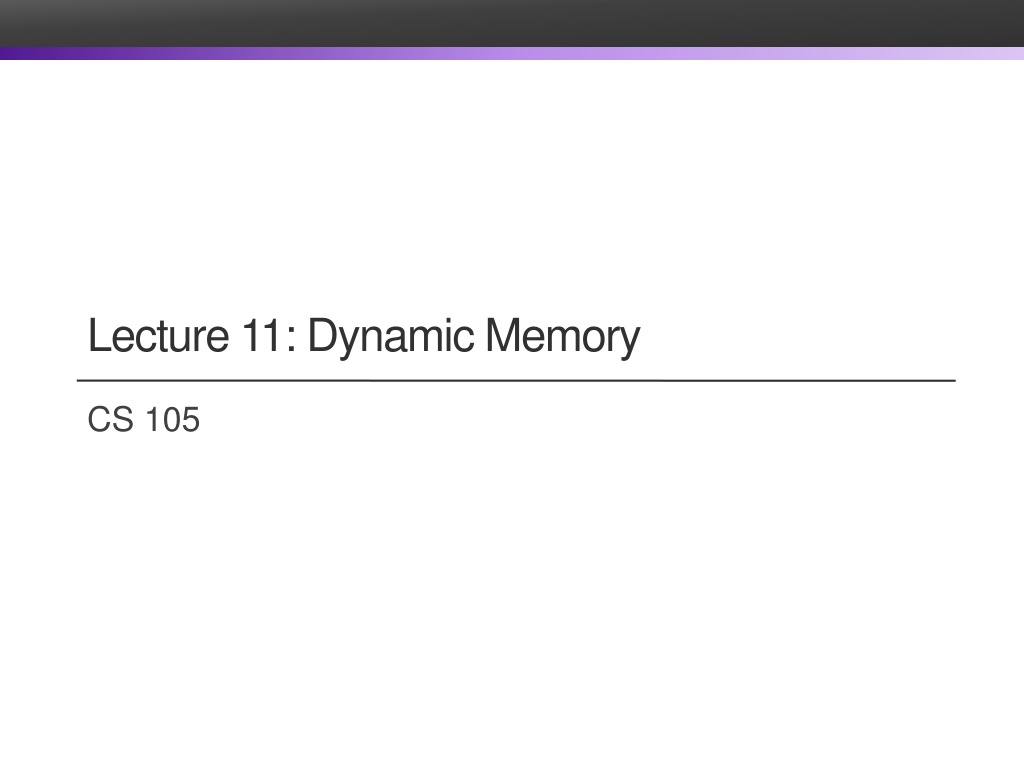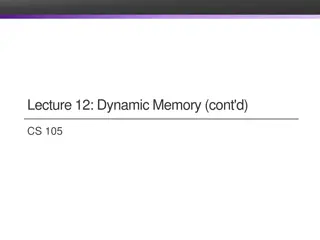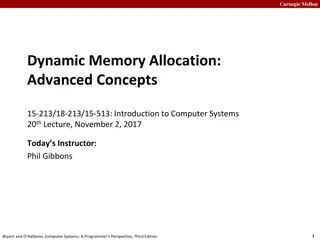Dynamic Memory Management Overview
Understanding dynamic memory management is crucial in programming to efficiently allocate and deallocate memory during runtime. The memory is divided into the stack and the heap, each serving specific purposes in storing local and dynamic data. Dynamic memory allocators organize the heap for efficient allocation and deallocation of memory blocks, allowing programmers to request additional memory at runtime. Through examples using functions like malloc and free in C, programmers can manage memory allocation effectively.
Download Presentation

Please find below an Image/Link to download the presentation.
The content on the website is provided AS IS for your information and personal use only. It may not be sold, licensed, or shared on other websites without obtaining consent from the author. Download presentation by click this link. If you encounter any issues during the download, it is possible that the publisher has removed the file from their server.
E N D
Presentation Transcript
Lecture 11: Dynamic Memory CS 105
Memory 0x7FFFFFFFFFFF Stack byte addressable array made up of four logical segments %rsp stack provides local storage for procedures "top" of the stack stored in register %rsp heap is an area of memory maintained by a dynamic memory allocator operating system maintains variable brk that points to the top of heap brk Heap data stores global variables code stores program instructions Data attempt to access uninitialized address results in exception (segfault) %rip Code 0x000000000000
The Heap 0x7FFFFFFF Stack the heap is an area of memory for dynamic memory allocation %rsp programmers can use a dynamic memory allocator to acquire additional memory at run time brk Heap Data programmers can use a system call to modify brk (e.g., extend the heap) %rip Code 0x00000000
4 Dynamic Memory Allocation Dynamic memory allocator Manages the heap organizes the heap as a collection of (variable-size) blocks, each of which is either allocated or free allocates and deallocates memory may ask OS for additional heap space using system call sbrk() Part of the process s runtime system Linked into program Example dynamic memory allocators malloc and free in C new and delete in C++ object creation & garbage collection in Java object creation & garbage collection in Python explicit allocators implicit allocators
5 Allocation Example using malloc #include <stdio.h> #include <stdlib.h> void foo(int n) { int i, *p; /* Allocate a block of n ints */ p = (int *) malloc(n * sizeof(int)); if (p == NULL) { perror("malloc"); exit(0); } /* Initialize allocated block */ for (i=0; i<n; i++) p[i] = i; /* Return allocated block to the heap */ free(p); }
6 Allocation Example p1 = malloc(4) p2 = malloc(5) p3 = malloc(6) free(p2) p4 = malloc(2)
Allocator Requirements Must handle arbitrary request sequences: cannot control number, size, or order of requests (but we'll assume that each free request corresponds to an allocated block) 1) Must respond immediately: no reordering or buffering requests 2) Must not modify allocated blocks: can only allocate from free memory on the heap cannot modify or move blocks once they are allocated 3) Must align blocks: 8-byte (x86) or 16-byte (x86-64) alignment on Linux Ensures that allocated blocks can hold any type of data 4) Must only use the heap: any data structures used by the allocator must be stored in the heap 5)
8 First Example: A Simple Allocator Advantages Simple Blazing fast void *malloc (size_t size) { return sbrk(align(size)); } Disadvantages Memory is never recycled Wastes a lot of space void free (void *ptr) { // do nothing }
9 Allocator Goals Throughput: number of requests completed per time unit Make allocator efficient Example: if your allocator processes 5,000 malloc calls and 5,000 freecalls in 10 seconds then throughput is 1,000 operations/second Memory Utilization: fraction of heap memory allocated Minimize wasted space max ? ? ????? ????????? ?? ???? ? Peak Memory Utilization ??= ???? ?? ??? ?? ???? ?
Exercise 0: Memory Utilization max ? ?????? ????????? ?? ???? ? ???? ?? ??? ?? ???? ? Recall that Peak Memory Utilization ??= ? = 0 ? = 1 ? = 2 ? = 3 ? = 4 ? = 5 What is the Peak Memory Utilization at time ? = 2? What is the Peak Memory Utilization at time ? = 5? ?/? ?/?
11 Allocator Goals Throughput: number of requests completed per time unit Make allocator efficient Example: if your allocator processes 5,000 malloc calls and 5,000 freecalls in 10 seconds then throughput is 1,000 operations/second Memory Utilization: fraction of heap memory allocated Minimize wasted space max ? ?????? ????????? ?? ???? ? ???? ?? ??? ?? ???? ? Peak Memory Utilization ??= These goals are often conflicting
12 Allocator Goals Throughput: number of requests completed per time unit Make allocator efficient Example: if your allocator processes 5,000 malloc calls and 5,000 freecalls in 10 seconds then throughput is 1,000 operations/second Memory Utilization: fraction of heap memory allocated Minimize wasted space max ? ?????? ????????? ?? ???? ? ???? ?? ??? ?? ???? ? Peak Memory Utilization ??= These goals are often conflicting
13 Utilization Blocker: Internal Fragmentation For a given block, internal fragmentation occurs if payload is smaller than block size Block Internal fragmentation Internal fragmentation Payload Caused by Overhead of maintaining heap data structures Padding for alignment purposes Explicit policy decisions (for example, returning a big block to satisfy a small request) Depends only on the pattern of previous requests Thus, easy to measure
14 Utilization Blocker: External Fragmentation Occurs when there is enough aggregate heap memory, but no single free block is large enough p1 = malloc(4) p2 = malloc(5) p3 = malloc(6) free(p2) p4 = malloc(6) Depends on the pattern of future requests Thus, difficult to measure
Exercise 1: Utilization Assume your heap is initially of size zero and you then run the following sequence of requests (below left) using the given allocator (below right) on a system with 4-byte alignment. What is the peak memory utilization after you complete the last request? max ? ?????? ????????? ?? ???? ? ???? ?? ??? ?? ???? ? Hint: Peak Memory Utilization ??= p1 = malloc(4) void *malloc (size_t size) { return sbrk(align(size)); } p2 = malloc(5) p3 = malloc(6) void free (void *ptr) { // do nothing } free(p2) p4 = malloc(2)
16 Exercise 1: Utilization p1 = malloc(4) p2 = malloc(5) p3 = malloc(6) free(p2) p4 = malloc(2)
17 Challenges Goal: maximize throughput and peak memory utilization Implementation challenges: How do we know how much memory to free given just a pointer? How do we keep track of the free blocks? How do we pick a block to use for allocation? What do we do with the extra space when allocating a structure that is smaller than the free block it is placed in? How do we reinsert a freed block?
18 Knowing How Much to Free Standard method Keep the length of a block in the word preceding the block. This word is often called the header fieldorheader Requires an extra (4 byte) word for every allocated block p0 p0 = malloc(16) 20 header = block size payload free(p0)
19 Challenges Goal: maximize throughput and peak memory utilization Implementation Challenges: How do we know how much memory to free given just a pointer? How do we keep track of the free blocks? How do we pick a block to use for allocation? What do we do with the extra space when allocating a structure that is smaller than the free block it is placed in? How do we reinsert a freed block?
20 Keeping Track of Free Blocks Method 1: Implicit list using length links all blocks 20 16 24 8
21 Method 1: Implicit List For each block we need both size and allocation status Could store this information in two words: wasteful! Standard trick If blocks are aligned, some low-order address bits are always 0 Instead of storing an always-0 bit, use it as a allocated/free flag When reading size word, must mask out this bit 4 bytes a = 1: Allocated block a = 0: Free block Size a Format of allocated and free blocks Size: block size Payload Payload: application data (allocated blocks only) Optional padding
22 Detailed Implicit Free List Example Unused Start of heap 8/0 16/1 32/0 16/1 0/1 Allocated blocks: shaded Free blocks: unshaded Headers: labeled with size in bytes/allocated bit 8-byte aligned
Exercise 2: Block Headers Determine the block sizes and header values that would result from the following sequence of malloc requests. Assume that the allocator uses an implicit list implementation with the block format just described and maintains 8-byte alignment. 4 bytes Request malloc(1) malloc(5) malloc(12) Block size (decimal) Block header (hex) Size a 8 0x00000009 16 16 0x00000011 0x00000011 Payload Optional padding
25 Keeping Track of Free Blocks Method 1: Implicit list using length links all blocks 5 4 6 2 Method 2: Explicit listamong the free blocks using pointers 5 4 6 2 Method 3: Segregated free list Different free lists for different size classes Method 4: Blocks sorted by size Can use a balanced tree (e.g. Red-Black tree) with pointers within each free block, and the length used as a key
26 Challenges Goal: maximize throughput and peak memory utilization Implementation Challenges: How do we know how much memory to free given just a pointer? How do we keep track of the free blocks? How do we pick a block to use for allocation? What do we do with the extra space when allocating a structure that is smaller than the free block it is placed in? How do we reinsert a freed block?
27 Implicit List: Finding a Free Block First fit. Search list from beginning, choose first free block that fits: p = start; while ((p < end) && \\ not passed end ((*p & 1) || \\ already allocated (*p <= len))) \\ too small p = p + (*p & -2); \\ goto next block (word addressed) Can take linear time in total number of blocks (allocated and free) In practice it can cause splinters at beginning of list Next fit. Like first fit, but search list starting where previous search finished: Should often be faster than first fit: avoids re-scanning unhelpful blocks Some research suggests that fragmentation is worse Best fit. Search the list, choose the best free block: fits, with fewest bytes left over: Keeps fragments small usually improves memory utilization Will typically run slower than first fit
28 Challenges Goal: maximize throughput and peak memory utilization Implementation Challenges: How do we know how much memory to free given just a pointer? How do we keep track of the free blocks? How do we pick a block to use for allocation? What do we do with the extra space when allocating a structure that is smaller than the free block it is placed in? How do we reinsert a freed block?
29 Implicit List: Allocating in Free Block Allocating in a free block: splitting Since allocated space might be smaller than free space, we might want to split the block 16 17 24 9 p addblock(p, 4) 8 16 17 17 9 void addblock(ptr p, int len) { int newsize = ((len + 1) >> 1) << 1; // round up to even int oldsize = *p & -2; // mask out low bit *p = newsize | 1; // set new length if (newsize < oldsize) *(p+newsize) = oldsize - newsize; // set length in remaining } // part of block
30 Summary of Key Allocator Policies Free-block storage policy: Implicit lists, with boundary tags (nice and simple) Explicit lists, exclude free blocks (faster, but more overhead) Segregated lists (different lists for different sized blocks) Fancy data structures (red-black trees, for example) Placement policy: First-fit (simple, but lower throughput and higher fragmentation) Next-fit (higher throughput, higher fragmentation) Best-fit (lower throughput, lower fragmentation segregated free lists approximate a best fit placement policy without having to search entire free list Splitting policy: When do we go ahead and split free blocks? How much internal fragmentation are we willing to tolerate?
31 Challenges Goal: maximize throughput and peak memory utilization Implementation Challenges: How do we know how much memory to free given just a pointer? How do we keep track of the free blocks? How do we pick a block to use for allocation? What do we do with the extra space when allocating a structure that is smaller than the free block it is placed in? How do we reinsert a freed block?
Exercise 4: Feedback 1. Rate how well you think this recorded lecture worked 1. Better than an in-person class 2. About as well as an in-person class 3. Less well than an in-person class, but you still learned something 4. Total waste of time, you didn't learn anything 2. How much time did you spend on this video (including exercises)? 3. Do you have any particular questions you d like me to address in this week s problem session? 4. Do you have any other comments or feedback?























